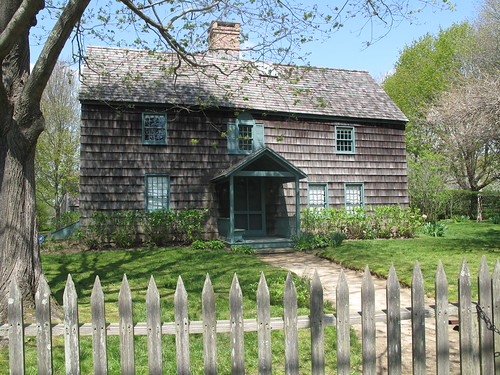
SO, FROM THE FLORAL EXTRAVAGANZA OF RANCHO LA PUERTA to the bare dirt of my own garden-to-be in Springs, N.Y., above. It’s a tough transition, but I’m doing my best.
I spent yesterday afternoon moving things around. Early spring is the best time of year to do that for most perennials, before things get too far along and you’re dealing with floppy greenery.
My focus is on creating some curb appeal, so when I drive up to my house, I say “Wow!” instead of “Oy!” I’m slowly filling in the planting beds I carved out from the former driveway. Last fall, I sculpted the shapes I wanted with piles of oak leaves. In late winter, I had a truckload of topsoil (and a bit of compost – not nearly enough) delivered and spread by Whitmore’s Nursery. More recently, I schlepped and spread an additional twenty-two 40-lb. bags of purchased compost myself.

Getting there…
I’m trying to create viable planting areas out of completely useless, compacted soil. What’s alarming is I’ve seen exactly one worm so far this spring (worms being a sign of soil fertility). But when I dig down to plant, the soil looks reasonably rich and properly crumbly, at least on the surface and a few inches below. There are a still a lot of un-decomposed oak leaves, but I leave them in place to continue their cycle of decay.
This being tax month, I am trying to do what I can without spending a cent. That means, first of all, moving green things from the rear of the property to the front, and over the next few weeks, begging perennial divisions from gardening friends and relatives.
Here’s what I transplanted yesterday from back to front:
- 5 Korean boxwoods bought last spring at Home Depot. I adore boxwoods – they’re tidy, evergreen, and deer-proof. These are small — just 1′ tall and 1′ wide, eventually to double in size. Can never have enough boxwoods.
- In addition to a wonderful glade of foot-tall ferns in the backyard, there were two existing clumps of another, taller type. I dug up one longstanding clump of these three-footers — easier said than done, as the clump was a couple feet across, with several starting-to-unfurl fronds and a thick mass of roots — and sawed it into five sections. I transplated them around my small front deck and watered them in well with a fish emulsion fertilizer — for no particular reason, except that’s what I had in the cupboard.
- Six astilbes that had been stuck in the back for temporary holding
Along with the half-price perennials I bought at Spielberg’s in East Hampton (I can’t say they’ve taken off yet, but they’re settling in) — including five each of lady’s mantle, blue ‘May Night’ salvia, an ornamental grass, some white creeping phlox, three ligularia — well, there’s still a whole lot of bare dirt, below. But I remember how quickly my garden at Dean Street in Boerum Hill, Brooklyn, came together once things got growing (“from nil to abundance in two seasons,” as my own blog post put it), and that gives me hope.

…but still quite a ways to go
My color scheme? Blue, purple, yellow, white, for the most part. This partly of necessity, as orange and red flowers seem to be mainly sun-lovers, and while it’s pretty bright around here at the moment, I expect things to become considerably shadier once the surrounding trees leaf out.
Note: I’ve been contributing blog posts to Garden Design magazine’s website. They mostly link back to this blog, so it’s all rather circular, but if you’d like to take a look, go here (there’s other stuff on the site besides my blog posts).





























